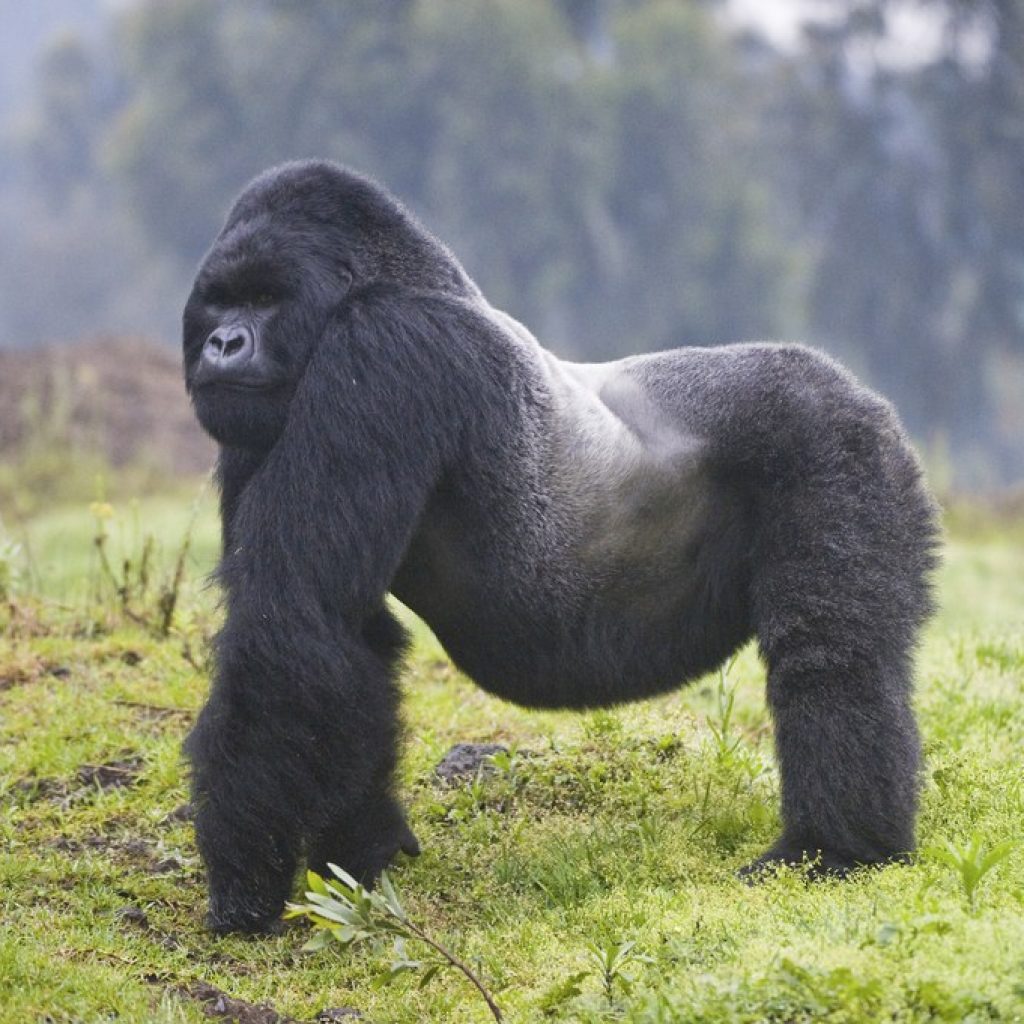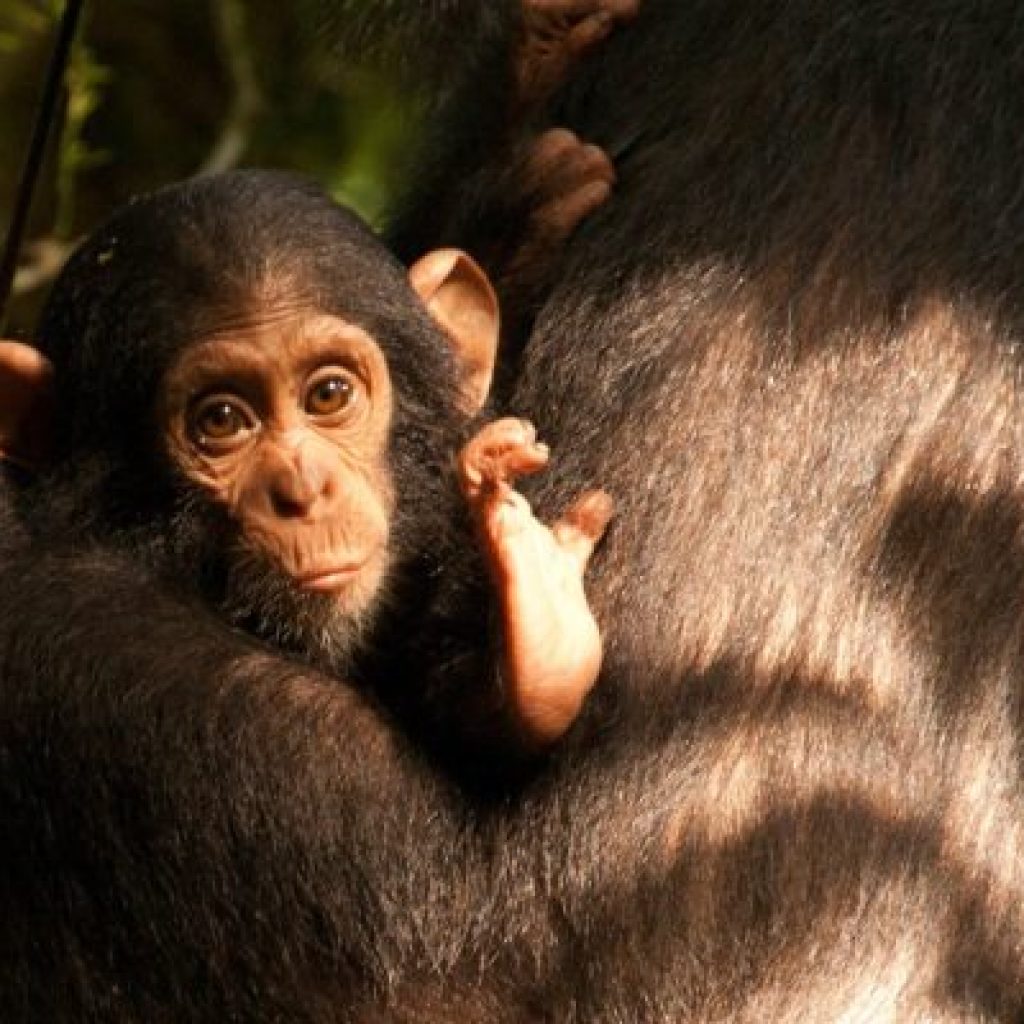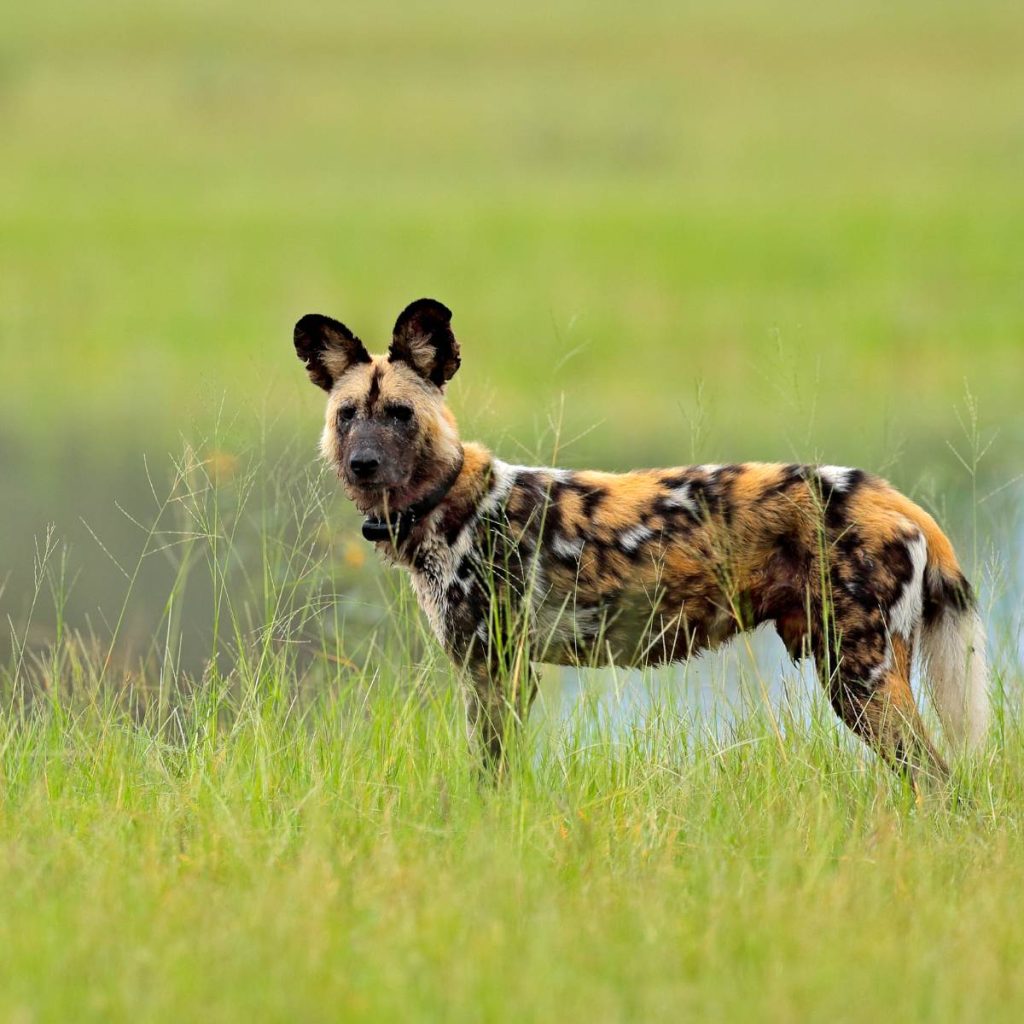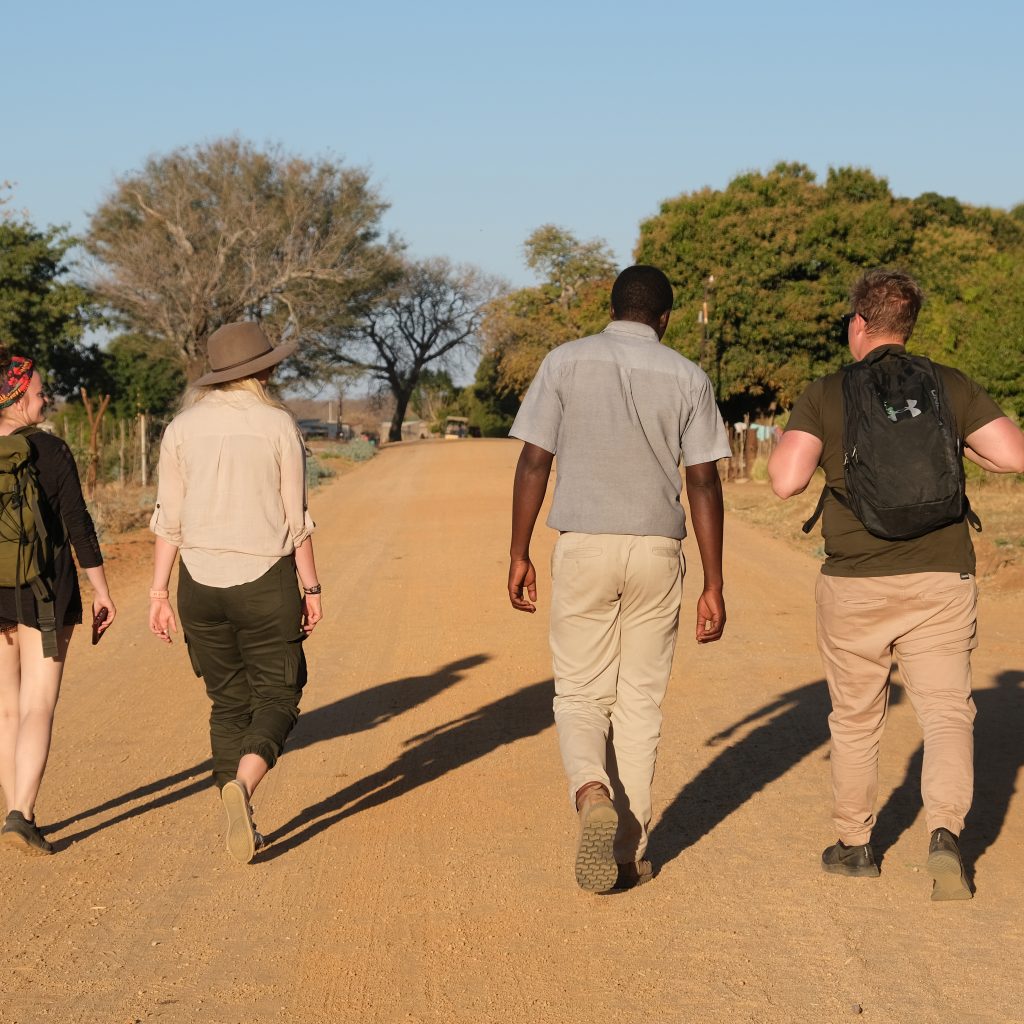
The Volcano Mountains that straddle the borders of Rwanda, Uganda and the Democratic Republic of Congo, are home to around 480 mountain gorillas, more than half of the world’s entire population (the rest live in Bwindi Impenetrable Forest in Uganda). In Volcanoes National Park, the Rwandan part of the Virungas, twelve gorilla groups are now habituated for gorilla safaris, more than anywhere else in the world.
Look into the eyes of a large silverback gorilla and he’ll look back with a thoughtful, intelligent gaze, mindful that you’re another individual. Any apprehensions or nerves you might have had during your trek will melt away the minute you see your gorilla family. Gorilla trekking safaris offer a magical encounter that transcends any other ’wildlife’ experience we know.![]()

![]()
Planning your gorilla trekking safari![]()
When to go gorilla trekking
Gorilla trekking safaris can be done throughout the year. The hiking itself can be more arduous in the rainy seasons from April – May and in November, but at an altitude of 2000m and more, it can of course rain here at any time of the year. For more details, see Rwanda’s climate.
The most popular times for gorilla tracking are during the drier months, between December and February, and from about June to mid-September.
Permits for gorilla trekking![]()

![]()
Inevitably, securing permits for trekking gorillas over these popular periods can be difficult at short notice, so you should plan well ahead. We will make all the arrangements for buying your permits.
A maximum of 96 gorilla tracking permits are available each day. As of 6th May 2017, the Rwandan Development Board has increased the costs of the gorilla permits from US$ 750 to US$ 1,500 per person, for a one-hour visit. The new prices aim to strengthen conservation efforts and support the development of local communities. Travellers who are also spending a minimum of three nights in either Nyungwe Forest National Park or Akagera National Park during the months of November to May are entitled to a 30% discount – reducing the costs to US$ 1,050 per person. Amongst other things, the permit pays for a 24-hour guard for each gorilla group (armed teams constantly track each habituated group – like royal bodyguards in the UK!).
How fit do I need to be to track gorillas?
You don’t have to be super-fit for a gorilla tracking safari but it does help if you have a general level of fitness, if only to enhance your overall enjoyment of the experience. Walking will be at a slow pace, with time for breaks if needed. Depending on which group you track, and the time of year you go (gorillas tend to move down the mountains in the rains), you might find yourself walking on some pretty steep slopes for several hours. On the other hand, you could reach your group after a 30-minute stroll. It’s best to prepare for the most active option however, and if nothing else, a few hill walks before you leave would be beneficial.
The gorilla trekking experience in Volcanoes National Park
Whilst a gorilla trekking safari is likely to be a once-in-a-lifetime experience for you, the staff at Volcanoes National Park have been doing this for several years and run a very smooth operation, hence treks to the mountain gorillas are well-organised and clearly structured.
What it’s like on a gorilla trekking safari![]()
On the day of your gorilla trekking, you’ll set off very early in the morning to track to the apes from the edge of the forest. Your driver/guide will take you from your lodge (see places to stay in Volcanoes National Park) to the park headquarters in Kinigi village. The guides here speak excellent English and are very good. They will be taking you to a specific group of ’habituated’ mountain gorillas, which are used to human visitors, and known well by the guides.
You’ll be divided into parties of 8 and, after a briefing on safety and gorilla trekking etiquette, you’ll be driven to the start of the trail to reach your mountain gorilla group. Your guide will then lead you along generally clear paths up into the forest, in radio communication with the trackers that stay with the group so that they can be located. The altitude is over 2,500m, so although the pace is unhurried, the hike is tiring and can be steep in parts, taking from 30 minutes to a few hours. Don’t be surprised if you feel a bit breathless at this altitude – this is perfectly normal.
Most trekkers are a little apprehensive – a large silverback male gorilla can weigh up to 200kg, or three times the weight of the average man, but the apprehension usually vanishes when you see the group. Often the gorillas will be spread around a small area of dense vegetation. They’ll continue with their feeding and interactions, nonchalant about their visitors, though watching you with interest. Occasionally one, often a playful youngster, will approach you with curiosity – sometimes coming so close that you’ll have to move away.
Gorilla tracking etiquette
Mountain gorillas share 98% of our DNA and as such are very susceptible to catching human infections, particularly respiratory ones, but they don’t have our immune system to deal with them – a common cold could eventually prove life-threatening. Various rules for gorilla trekking are therefore in place to help protect these precious primates. ![]()
Only one group of tourists can visit the mountain gorillas each day and once you’ve found them, you’ll have just one precious hour in their company. If you have a cold, flu or other contagious infection, you shouldn’t go gorilla trekking.
You should keep a distance of 7m from the gorillas, although of course the gorillas themselves are unaware of this and will often get very close, in which case you should try to move away.
When you’re with your group, you should try not to make sudden movements and to keep your voices low so that the group remains relaxed. Although these mountain gorillas are now used to seeing people, do bear in mind that they are still wild animals and can sometimes react unexpectedly, so always heed your guide’s and trackers’ instructions.
You won’t be allowed to eat or drink when you’re with the gorillas.
What kit should you take for a gorilla trekking safari?![]()
Paths on gorilla treks can be slippery, muddy and steep so sturdy walking boots are essential. Some people take thick gardening gloves because of the brambles and nettles en route and you should wear long trousers rather than shorts. A waterproof jacket may come in handy and take some water and a snack in case it’s a long trek. You might also find a walking stick or pole helpful.
For a small fee, porters are available at the trailheads to carry your backpacks and offer a hand during tricky parts of the hike. Even if you don’t really need them, hiring a porter is a helpful way to contribute directly to the local economy and chatting to them en route can enhance your experience both of local life and of your gorilla trek.
Photography on a gorilla trekking safari![]()

![]()
If you’re a keen photographer, taking your own pictures of mountain gorillas is one of the most magical photo sessions you’ll ever experience. Do bear in mind that the light can be poor in the rain forest and that use of flash is not permitted. You might also need to protect your camera against heavy rain.
Mountain gorilla groups in Rwanda’s Volcanoes National Park
The various groups and their locations will obviously change from time to time: mountain gorillas often climb higher in the dry season and descend during the rains, they might move on due to pressure from wild gorillas and individuals will often join other groups. When tracking gorillas, it’s possible to request to visit a specific group once you are at the park headquarters, but this can never be guaranteed. These are some of the groups currently habituated for gorilla safaris in Volcanoes National Park:
• The Sabyinyo Group has about 12 individuals, including two silverback gorillas, and is usually found relatively close to the edge of the forest (about 20–40-minutes’ walk), between Sabyinyo and Gahinga.
• Agashya Group, also known by its former name Group Thirteen, usually lives close to the Sabyinyo Group but can range very far and high. It has about 25 gorillas with 2 silverbacks.
• Usually living between the Karisoke and Visoke (sometimes called Bisoke) peaks are the Amahoro Group, with about 17 individuals, and the Umubano Group, which currently has 11 members. Both are usually further away from the headquarters than the Sabyinyo and Agasha groups, but easier to reach than the Susa Group.
• Originally studied by Dian Fossey, the Susa Group was the largest, with about 40 individuals, including 3 silverbacks. After a split (creating Igisha Group) in 2009, Susa now has 28 members. In the summer months in particular it can be a tough trek to reach this group high up on Mount Karisimbi, but it’s well worth the effort because of their number and because, uniquely, it has two sets of twins, which is very rare..
• The Karisimbi Group, which split from the Susa group a few years ago, also lives in the Mt. Karisimbi area of Volcanoes National Park and is also suited to visits from more serious hikers. Both of these groups can potentially involve a full day’s trek. This group also underwent a split in 2012, and now has 11 individuals.
• The Hirwa Group has around 11 members including one silverback and another pair of twins. Together with the two pairs of twins in the Susa group, these are the only known surviving twins of mountain gorillas in the world. They’re also usually found on the slopes of Sabyinyo, and tend to be one of the easier groups to trek to
• The Kwitonda Group has 18 members and was habituated in the DRC. They crossed the border into Rwanda in 2005, and were carefully tracked and are now also being visited on a regular basis, although they are known to range far.
• The Bwenge Group, named after their silverback, has 11 members and can be a tough trek – they’ve had a lot of in-fighting and have lost a few family members, and they move around a lot, and faster.
• The Ugende Group do the same, so it’s often a harder trek. The name means “on the move” – its 11 individuals shift regularly.
• Isimbi Group were formed after the Karisimbi group split in 2012, and includes Poppy, the oldest living female (though she went missing at the end of August 2018, so her future looks a little uncertain). They have 14 members.
Safaris to Volcanoes National Park
The town of Musanze (more commonly known by its former name Ruhengeri) is the hub of Rwanda’s gorilla trekking tourism, with plenty of cafes, bars and restaurants, and is easily accessible on a 1-2 hour drive from the capital Kigali. Volcanoes National Park’s Headquarters are based in the nearby village of Kinigi, the administrative centre for permits and the place where all visitors gather in the mornings for briefings before starting on their gorilla treks.
The issuing of gorilla tracking permits is strictly regulated in Volcanoes National Park (see Gorilla trekking safaris in Rwanda for further information on this) so it’s advisable to plan your holiday well ahead, particularly if you want to travel to Rwanda in the busy period between June and September, to guarantee availability.
Safari camps and lodges in and around Volcanoes![]()
There are several options for accommodation near Volcanoes National Park, and quite a range of choices – from simple and basic, to more upmarket. Those in Ruhengeri and Kinigi generally fall into the lower budget categories while the more expensive lodges can be found on the outskirts of the park or scattered further afield. Take a look at Where to Stay for our favorites.
Tourism in Volcanoes National Park is well established. For the most part, the gorilla tracking experiences and hotels operate smoothly and the people are friendly, appreciating the value of visitors to their economy and their area. Indeed, some of the lodges actively work with the local communities on projects for job creation and education, offering interesting visits to local villages.
Activities on a Volcanoes National Park holiday
Gorilla tracking safaris in Volcanoes National Park![]()
There is no other wildlife experience quite like an encounter with mountain gorillas. That precious hour spent in their company – watching the group playing, sulking, teasing each other, eating, or dozing just like we do – is extraordinary. And the gorilla tracking safaris in Rwanda’s Volcanoes National Park are among the best in Africa.
Rwanda is now home to twelve habituated groups of mountain gorillas that are scattered all over Volcanoes National Park. You’ll leave early in the morning for your briefing at the Park HQ and then in parties of eight will be taken to your allocated group with a guide and trackers. Gorilla trekking can be arduous – some of the groups wander high up the mountainsides – but it is always utterly rewarding. Take a look at Gorilla trekking safaris in Rwanda for further information on the experience, etiquette and tips on gorilla trekking. Encounters can never be guaranteed, but any time spent with them will never be forgotten.
Other Trips in Volcanoes National Park![]()
You don’t have to track gorillas to go trekking in Volcanoes National Park – there are other interesting hiking trails here. Before your visit to the gorillas, a guided walk into the mountains can be good for acclimatisation. It also allows you to spend more time looking at the other wildlife in forest, and to gain a better understanding of the overall ecosystem.
One of the more popular routes is to the tomb of Dian Fossey and the Karisoke Research Centre she established, which takes a couple of hours of fairly steep walking. Another beautiful option is a day hike to the crater lake on Mount Bisoke.
Several other primates have made Volcanoes National Park their home too and it’s possible to track two troops of habituated golden monkeys, a totally different experience to gorilla tracking. Golden monkeys tend to inhabit the bamboo forests on the lower slopes, so the walk to reach them is relatively easy. Again, once you find them, you’ll have just an hour in their presence. They’re fast-moving little creatures, and very entertaining as they constantly swing through the bamboo or chase each other in circles all around you. They’re also very pretty, with shiny reddish-gold backs that blend in perfectly with the golden bamboo.![]()
People are as much a part of Volcanoes National Park as its primates and a visit to one of the cultural centres in the area to gain an insight into local life and traditions is not only very interesting but also benefits the local communities and deters them from engaging in negative activities like poaching. Two very good examples are the SACOLA Cultural Centre, with excellent traditional Intore dancing, and Iby’Iwacu Cultural Village, both near Kinigi.
Wildlife of Volcanoes National Park![]()
![]()
Even without mountain gorilla safaris, Volcanoes National Park would be fascinating. Its altitude ranges from about 2,500m to the peak of Karisimbi, at 4,500m, resulting in extensive bamboo forests and some of the last remaining afro-montane forest habitat on the planet. On the higher slopes you’ll find an almost otherworldly habitat of thick moors with endemic giant lobelia and groundsel.
As well as its infamous mountain gorillas, the Park harbours a spectacular array of rare and endangered animals and plants. There is a variety of other primates, including the endemic golden monkeys, plus forest elephants, buffalo, giant forest hogs (Africa’s largest swine), bushpigs, bushbucks, black-fronted duikers, spotted hyenas, and around 200 species of birds.
By Golden Rwanda Safaris “THE SMART SAFARI COMPANY FOR YOU”






About The Author: Frank Benoit Kanyamutara
More posts by Frank Benoit Kanyamutara